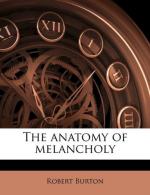as [6522]Croesus, king of Lydia, [6523] Marcus Julianus,
surnamed ob crebras hostias Victimarius, et Tauricremus,
and the rest of the Roman emperors usually did with
such labour and cost; and not emperors only and great
ones, pro communi bono, were at this charge,
but private men for their ordinary occasions.
Pythagoras offered a hundred oxen for the invention
of a geometrical problem, and it was an ordinary thing
to sacrifice in [6524]Lucian’s time, “a
heifer for their good health, four oxen for wealth,
a hundred for a kingdom, nine bulls for their safe
return from Troja to Pylus,” &c. Every god
almost had a peculiar sacrifice—the Sun
horses, Vulcan fire, Diana a white hart, Venus a turtle,
Ceres a hog, Proserpine a black lamb, Neptune a bull
(read more in [6525] Stuckius at large), besides sheep,
cocks, corals, frankincense, to their undoings, as
if their gods were affected with blood or smoke.
“And surely” ([6526]saith he) “if
one should but repeat the fopperies of mortal men,
in their sacrifices, feasts, worshipping their gods,
their rites and ceremonies, what they think of them,
of their diet, houses, orders, &c., what prayers and
vows they make; if one should but observe their absurdity
and madness, he would burst out a laughing, and pity
their folly.” For what can be more absurd
than their ordinary prayers, petitions, [6527]requests,
sacrifices, oracles, devotions? of which we have a
taste in Maximus Tyrius, serm. 1. Plato’s
Alcibiades Secundus, Persius Sat. 2. Juvenal.
Sat. 10. there likewise exploded, Mactant
opimas et pingues hostias deo quasi esurienti, profundunt
vina tanquam sitienti, lumina accendunt velut in tenebris
agenti (Lactantius, lib. 2. cap. 6).
As if their gods were hungry, athirst, in the dark,
they light candles, offer meat and drink. And
what so base as to reveal their counsels and give oracles,
e viscerum sterquiliniis, out of the bowels
and excremental parts of beasts? sordidos deos
Varro truly calls them therefore, and well he might.
I say nothing of their magnificent and sumptuous temples,
those majestical structures: to the roof of Apollo
Didymeus’ temple, ad branchidas, as [6528]Strabo
writes, a thousand oaks did not suffice. Who can
relate the glorious splendour, and stupend magnificence,
the sumptuous building of Diana at Ephesus, Jupiter
Ammon’s temple in Africa, the Pantheon at Rome,
the Capitol, the Sarapium at Alexandria, Apollo’s
temple at Daphne in the suburbs of Antioch. The
great temple at Mexico so richly adorned, and so capacious
(for 10,000 men might stand in it at once), that fair
Pantheon of Cusco, described by Acosta in his Indian
History, which eclipses both Jews and Christians.
There were in old Jerusalem, as some write, 408 synagogues;
but new Cairo reckons up (if [6529]Radzivilus may be
believed) 6800 mosques; Fez 400, whereof 50 are most
magnificent, like St. Paul’s in London.
Helena built 300 fair churches in the Holy Land, but




